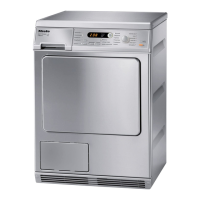
Do you have a question about the Miele T 8823 C and is the answer not in the manual?
| Type | Tumble dryer |
|---|---|
| Energy Efficiency Class | A++ |
| Load Capacity | 8 kg |
| Noise Level | 65 dB |
| Weight | 55 kg |
| Heat Pump Technology | Yes |
| Appliance placement | Freestanding |
| Loading type | Front Load |
| Drying system | Heat pump |
| Drum capacity | 8 kg |
| Drying class | A |
| Height | 85 cm |
| Color | White |
| Drum Volume | 112 l |
| Width | 595 mm |
Proper disposal methods for packing materials.
Guidelines for disposing of the old appliance responsibly.
Advice on how to reduce energy consumption during drying.
Intended use of the dryer and general safety precautions.
Measures to ensure child safety around the appliance.
Electrical safety, connection, and repair guidelines.
Safe usage practices and approved accessories.
Information regarding the use of genuine Miele spare parts and accessories.
Explanation of buttons, indicators, and the control panel interface.
Understanding information and indicators shown on the display.
Understanding programme timing and estimated time remaining.
Interpretation of laundry care labels for tumble drying.
Guidance on drying different fabric types and loads correctly.
Step-by-step guide for basic dryer operation.
Choosing programmes and available extra options.
Initiating, running, and removing laundry from a drying cycle.
Details on using optional functions like low temp, buzzer, and delay.
Procedure for adding items after setting a delay start.
How to change programmes or add items during/after a cycle.
Instructions for enabling or disabling the child lock feature.
Procedures for cleaning the condensed water container and fluff filters.
Maintenance of the appliance's housing and condenser unit.
Interpreting error codes and indicator lights on the display.
Addressing common problems like insufficient drying or static.
Solutions for issues like long drying times or no start.
Step-by-step guide for replacing the drum light bulb.
Information on software updates and available accessories.
Identifying parts and choosing a suitable installation location.
Ensuring proper setup for operation and water management.
Requirements for connecting the dryer to the power supply.
Customizing drying levels for different programmes.
Optimizing settings for wrinkle prevention and fabric handling.
Configuring energy saving, memory, indicators, and tones.
Adjusting for water quality and extending drying options.